There is an unwritten rule that food that has fallen to the ground can be eaten within 5 seconds. But is it really so?
Eugenio Spagnuolo
21 february
– Milano
The 5 second rule states that food that has fallen to the ground for a few moments can still be consumed. Second plus, second minus, the theory is that just picking up a food as it falls on the floor will prevent germs from jumping on it, making it inedible. But things are not quite like that …
The 5-second rule: study
—
A few years ago, two scientists from Rutgers University (USA) tried to establish the truth behind the 5-second rule, discovering that the speed and intensity of bacterial contamination on fallen food are determined by 3 factors: the type and consistency of the food (whether it is wet, dry, flat or dented …), the surface on which it falls (wood, carpet, tiles …) and finally the time in which it remains. Four products were considered for the study: watermelon, bread, buttered bread and jelly bears. And 4 different surfaces: steel, ceramic tiles, wood and carpet.
How long does ground food resist bacteria?
—
Each surface was inoculated with theenterobacter aerogenes, a non-pathogenic “cousin” of the bacterium Salmonella, which occurs naturally in our digestive system. The scientists dropped the food onto each surface for different fractions of time (less than a second, 5, 30 and 300 seconds), discovering that of the foods analyzed, watermelon was the one that accumulated the most bacteria. This because humidity drives the transfer of germs from the surface to the food. The wetter the food, the greater the risk of them jumping on it.
Surface matters
—
Then looking at the surfaces, tiles and stainless steel showed the highest rate of contamination transfer to food. That of the wood was variable and, surprisingly, carpets and rugs were the surfaces on which food was least contaminatedbecause they absorb germs and therefore have a lower rate of transfer of these to food.
Food not to be collected
—
Some foods, especially those rich in macronutrients and micronutrients necessary for microbial proliferation, such as raw meat, fish and cheese are more prone to contamination. Consequently, even in the presence of harmless microbes, it is best to follow the precautionary principle. Dry and solid foods, on the other hand, are a little safer. But it always depends on which surface they fall …
Contamination time
—
The bad news is that it takes less than a second for bacteria to contaminate a food. The good one that the longer a food stays on the ground, the more bacteria it collects: Food that has been on the ground for a second is always less contaminated than food that has been on the ground for five or ten seconds. In short, even hygiene is subject to the inexorable laws of time.
When food dropped on the ground is dangerous
—
The risk of eating food that has fallen on the floor is mainly related to where it falls more than for how long. For example, if a cookie falls on the floor in the hospital it would be better to throw it away and don’t eat it – hospitals harbor microbes that are resistant to antibiotics and can cause major infections. Likewise, better to avoid collecting finished food on the bathroom floor. In fact, researchers have shown that Salmonella Typhimurium can survive up to 4 weeks on what may appear to be a clean and dry surface.
The 5 second rule: conclusions
—
In short, the 5 second rule has no scientific basis, but this does not mean that we must throw away all the food that falls on the floor. In some cases it would be a waste of food, especially since our body can fight and defeat a good number of microbes. But we shouldn’t believe that getting in contact with floor bacteria will help our immune system either. Better to follow common sense and remember is that moist and sticky foods should be discarded, but dry and solid foods that fall on clean surfaces are mostly safe if they stay there for a few seconds. In short, first take care of the hygiene of the surfaces, then time the seconds in which the food remains on the ground. And finally ask ourselves if we can collect it or not.
© breaking latest news
